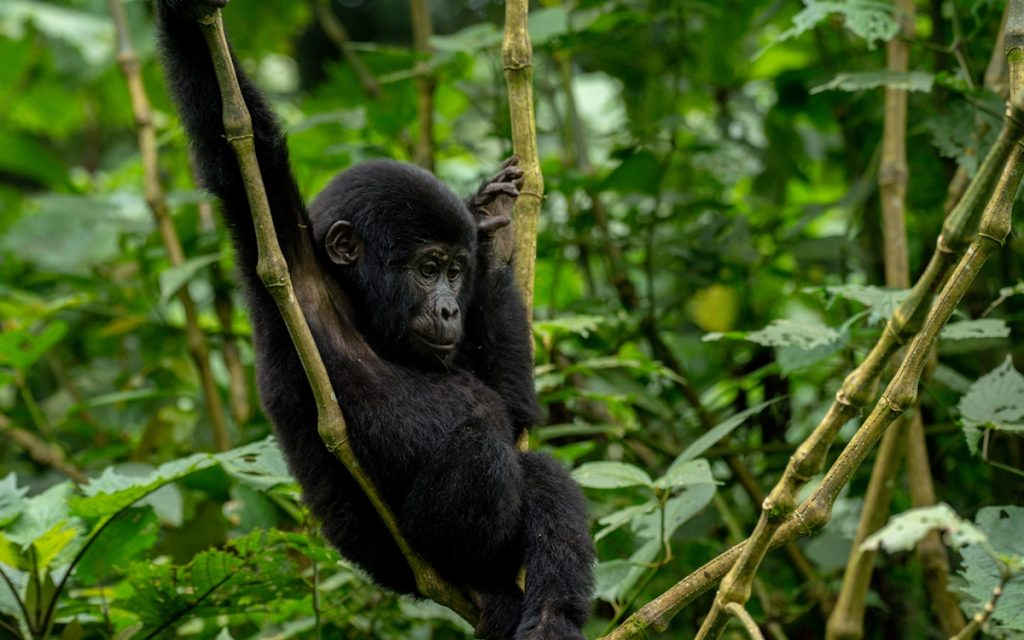- Written by: Brenda Bliss
- June 18, 2025
Ankole Cattle of Uganda
Ankole Cattle | Uganda’s Long-Horned Royalty
The Morning They Appear
If you’ve ever travelled that early morning road from Kampala toward Mbarara, you’ll understand how amazing the Ankole long horned cattle are. As you drive past banana plantations and matooke-laden bicycles, until one bend opens up into a wide valley shrouded in mist.
As the sun rises, the fog lifts like a curtain—and there they are. A slow-moving herd of Ankole cattle, with horns that stretch like spears of light toward the sky.
Even the bus drivers slow down because of how majestic they more. Boda-boda riders take a second look. And children on their way to school stop and whisper, “Eh, weebale!” It’s not because they’ve never seen cows.
It’s because these aren’t just cows. They’re royalty!
The Significance of the Ankole cattle
Here in Uganda, the Ankole cow is not just a symbol of wealth—it is a reflection of heritage, a quiet reminder of where we come from. They do not simply fill kraals; they fill memory, music, and meaning.
Every movement they make, every soft bellow in the morning fog, reminds us (especially the Ankole people) that there are still things that walk slowly and carry greatness.
Ankole cattle are known scientifically as part of the Sanga family—a blend of the hardy zebu and our indigenous humpless breeds.
But in our homes, they go by a more fitting name: enjovu y’ebisibo, the elephant of the herd. A name not given lightly.
Some mature Ankole bulls have horns wider than a Land Cruiser, moves with the calm confidence of a king.
You’d think such horns would make them clumsy, but no—they walk with the grace of dancers, each step deliberate, each turn gentle. Their eyes are deep and knowing, the kind of eyes that seem to carry songs that were never written, only passed down through silence.
Look at their coats and you’ll see nature’s brushwork. Some are mahogany, glistening like polished wood after rain. Others are the colour of fresh clay, or dusty cinnamon, or speckled cream like milk that’s been stirred with honey.
No two are the same. And for the people who raise them—across Kiruhura, Isingiro, Lyantonde—each cow has a name, a story, and often a song.
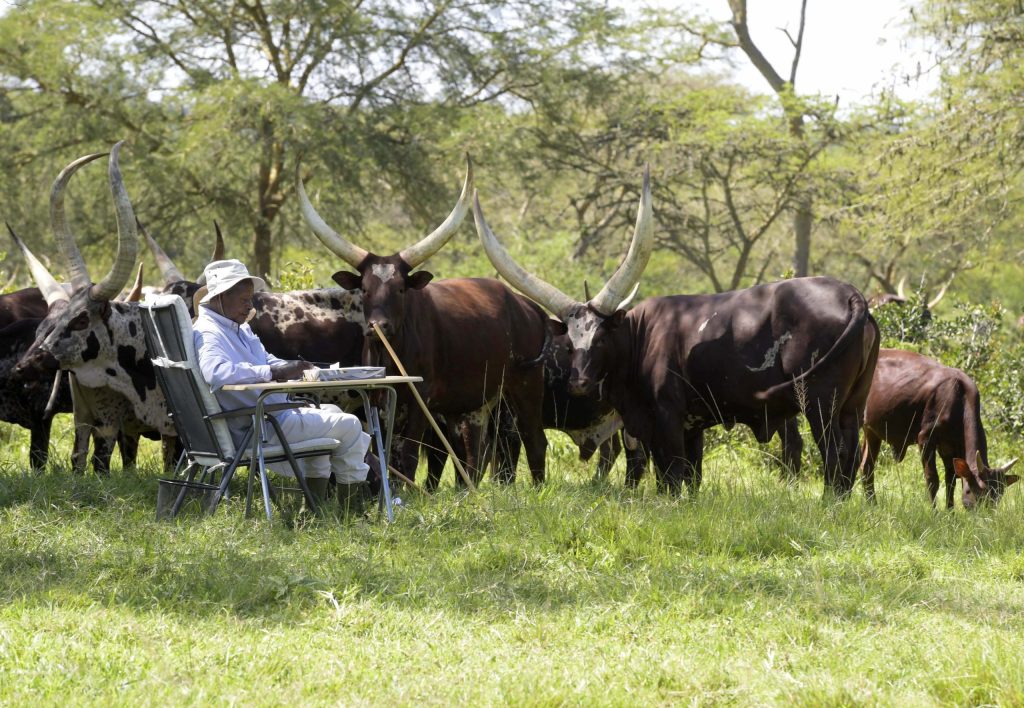
President Museveni in a Farm with Ankole Cattle
History of the Ankole Cattle
The value of Ankole cattle in western Uganda is immeasurable and respected. Families measure wealth not by shillings, but by hoofprints. If a man owns eight pure Ankole cows, he is considered well off.
Not just financially—but in wisdom, status, and social depth. You’ll hear it often in weddings, during dowry ceremonies. One sleek bull in the kraal can speak louder than any bank balance. When dusk falls and kraals fill with soft moos and the clang of cowbells, it’s like a lullaby only the soil understands.
Long before Uganda became a republic, long before colonial borders were drawn, the Bahima and Banyankole people were moving with these cattle. From the Nile basin, they followed the rains, chasing green pasture and safety.
And when they finally settled, the cattle were not left behind—they were at the heart of everything.
The Ankole Kingdom, that was formed in the 15th century, treated these animals not as livestock but as sacred. The royal herds, known as Enyambo, were untouchable. The king had a designated herdsman whose life was devoted to tending the cattle—rising before sunrise to polish horns, calling each animal by name, and even composing songs to praise their character.
To kill an Enyambo was unheard of. It was like burning a royal palace. These cows lived, were honoured, and died with dignity.
Suggested Safari Itineraries
14-Day Uganda, Congo & Rwanda Gorilla Trekking & Wildlife Safari
$ 4900
per personHorns Like Natural Air-Conditioners
During colonial times, administrators introduced European breeds that promised higher milk yields and faster growth. They came with paperwork, charts, and promises. Some Ugandans accepted them—for business.
But in many homes, the pure Ankole remained sacred. It didn’t matter if it produced less milk; what mattered was that it carried the spirit of a people.
That same spirit lives today, protected by groups like the Ankole Cow Conservation Association. They now even use DNA tests to ensure calves are “pure”—a scientific touch on something spiritual.
Those horns everyone admires? They’re not just ornaments. Inside, they’re built with a mesh of blood vessels that help regulate body temperature. While imported Holsteins struggle in the heat, you’ll find Ankoles out on the hill, swishing their tails with ease.
Their humps store energy for the dry season. Their digestive systems are designed for our tough savannah grass. And their hides? Thick enough to resist most pests. You don’t have to convince Ugandan herders of their brilliance. They already know.
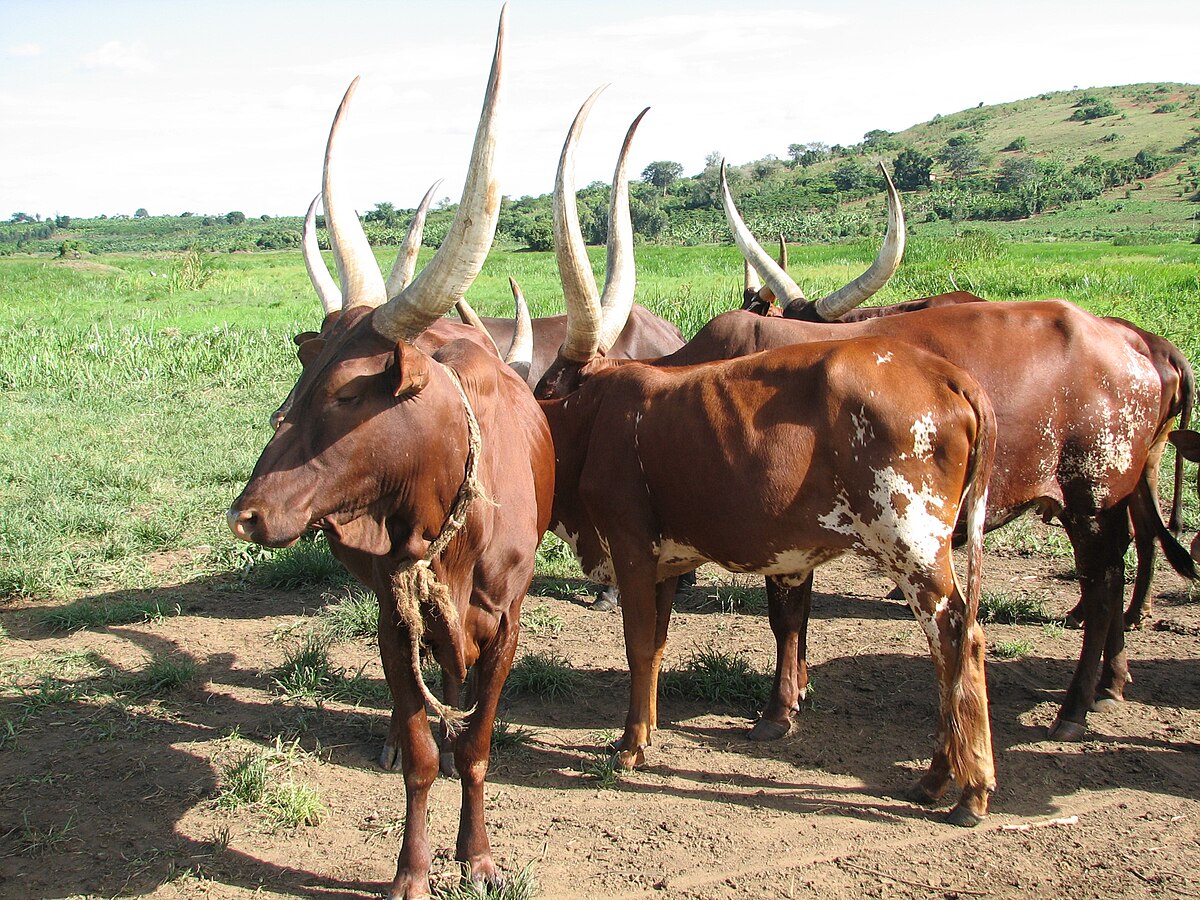
Ankole Cattle of Uganda
Cultural Currency & Significance to the Ankole people
In the villages, weddings like Okuhingira still honour Ankole milk. You’ll find wooden milk pots called ebyanzi lined up beside the matoke and groundnut stew. The milk—rich, thick, and gently boiled with omutungo herb—isn’t just a drink. It’s an offering. It’s how you welcome someone into your family. Then there’s eshabwe—clarified ghee whipped with smoked salt. Served during traditional ceremonies, it’s more than food. It’s generosity you can taste. Prestige is not in the quantity, but in the gesture. A spoon of eshabwe says: “You matter here.”
Ankole cattle are more than beautiful—they’re resilient. During dry spells when the grass turns yellow and the wind kicks up dust, many imported breeds shrink and suffer. But Ankoles? They keep going. They walk long distances to drink from distant swamps, graze on shrubs when pasture fades, and still return home at night, tired but not broken. Vets speak of their disease resistance with admiration. Herdsmen say it simply: “These cows are born knowing this land.”
Where to see the Long Horned Ankole Cattle
Mbarara (“Land of Milk”): Morning markets echo with gentle lowing. Some lodges organise kraal visits where guests learn traditional milking while balancing on low three-legged stools called ekito. It’s always important to inform us if you need to have a local cultural experience so that we can have this arranged for you.
Lake Mburo National Park: Picture a herd crossing the savannah behind zebras—the park is one of the few Ugandan reserves where pastoralists graze alongside wildlife.
Kiruhura & Nyabushozi Counties: Here, virtually every hilltop sports a thatched kraal. Ask politely, and a herdsman may invite you to sip warm milk straight from a calabash.
Igongo Cultural Centre: Its small museum dedicates a whole wing to Ankole pastoral life—tools, songs, children’s games, and horn-polishing rituals.
Rukungiri Highlands: Sunset horseback rides weave among free-grazing Ankoles whose horns silhouette against orange skies—photographer’s heaven.
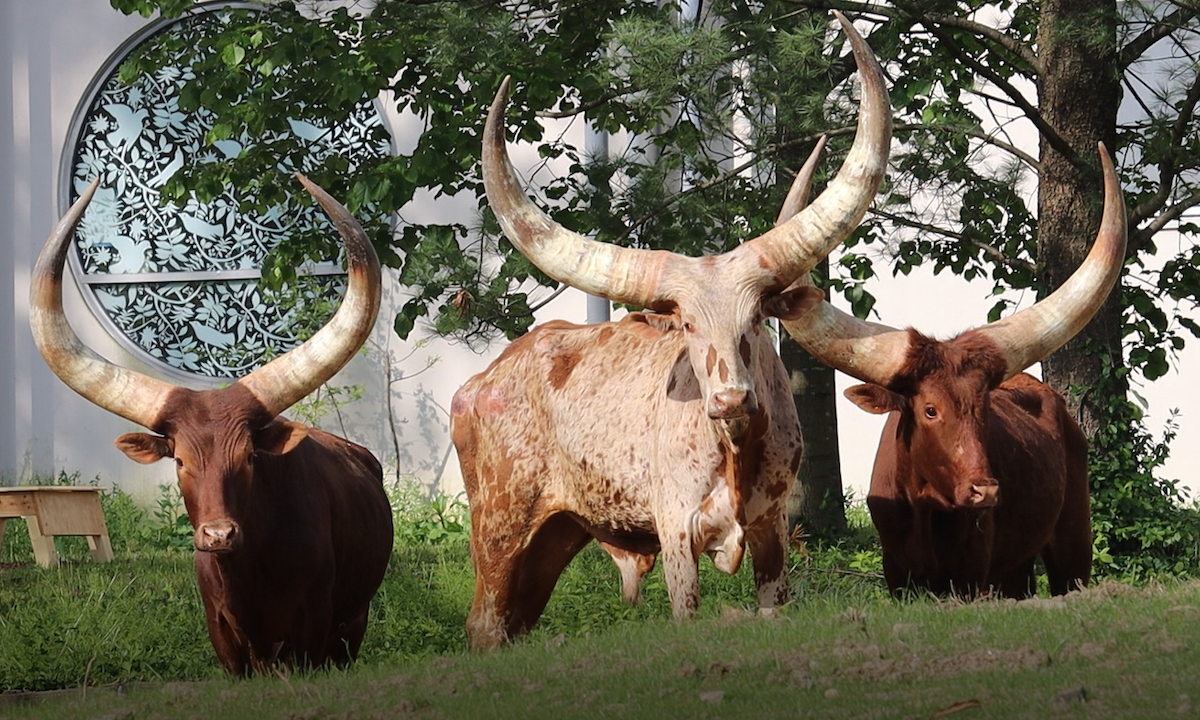
Ankole Cattle of Uganda in a Farm
Tips for Best Sightseeing
- Rise before the cock crows. Cattle leave kraals at dawn; horns catch first light like spears of pure gold.
- Try the milk warm, unsweetened. Sugar masks the earthy tang that makes Ankole milk unique.
- Listen more than you talk. Herdsmen speak softly; cows spook easily. A calm visitor earns a closer look.
- Pack patience. Ankole culture moves on cow time—slow, deliberate, rhythmic.
- If possible, buy a handmade horn comb or cup. It supports artisans and turns your suitcase into a mobile storybook.
Are the Ankole Cattle endangered?
Uganda’s growing towns keep eating up land and imported breeds offer more litres of milk. And many youth are leaving for the cities, chasing degrees and dreams that kraals can’t offer. Some even look at pure Ankole cattle as old-fashioned. But all is not lost. Ranches like Nshaara still raise only pure Ankoles.
Universities are preserving their genes. Tourism boards are waking up to their value. Every time a traveller stops to take a photo, a child somewhere in Ankole country sees that their culture has global worth.
Recommended Safaris
8 Days River Nile, Murchison Falls & Kidepo Wilderness Safari
$ 2400
per personLittle-Known Nuggets to Impress Your Friends
A healthy Ankole horn can grow over 12 centimetres a year. That its spiral can hint at lineage. That lullabies called okuhubira are still sung to calves. Our 10,000-shilling note once carried the face of an Ankole bull.
Queen Elizabeth II saw them and called them regal. In some kraals, a “priest cow” is still believed to predict droughts based on its movements. Folklore even tells of a bull that wept when its herdsman died. Whether true or not, no one who heard it doubted the emotion.
Frequently Asked Questions (Ankole Cattles FAQ)
How heavy are those horns really?
The long-horns of the Ankole cattle is surprisingly light. Because they are hollow, a full-grown set weighs little more than a jerry can of water.
Can tourists touch the cows?
With consent from the owner and calm approach, yes. Stroke the neck first; never grab a horn. A gentle “mpola, mpola”—slowly, slowly—soothes them.
Do Banyankole still avoid slaughtering Ankoles?
Many do. Families often keep a core group they will never butcher, using crossbreeds for beef.
Why is Ankole milk so thick?
Genetics. High butter-fat content gives it a natural creaminess perfect for eshabwe.
Is it true herders sing to individual cows?
Yes. Each prized animal—called ekitooro—receives its own song praising horn shape, coat colour, or docility.
Where can I buy authentic horn crafts?
There are many places but the best place is the roadside stalls along the Mbarara–Kabale highway or Kampala’s Buganda Road Craft Market.
How do Ankoles handle parasites?
They have thicker hides and produce a skin secretion that discourages ticks. Herders still dip them in acaricide baths, but less frequently than European breeds.
Are Ankoles only for the west?
Mostly, but pockets exist near Luweero and in Northern Uganda ranches.
Conclusion: Horns Pointing Toward Tomorrow
In a country where cities are rising fast and Wi-Fi reaches every corner, the Ankole cow still moves slowly. She walks with purpose. She feeds families. She connects past to present. When the sun finally disappears behind the Rwenzori, and the roads fall quiet, it is the sound of cowbells in the distance that reminds us: some legacies are not written—they walk.
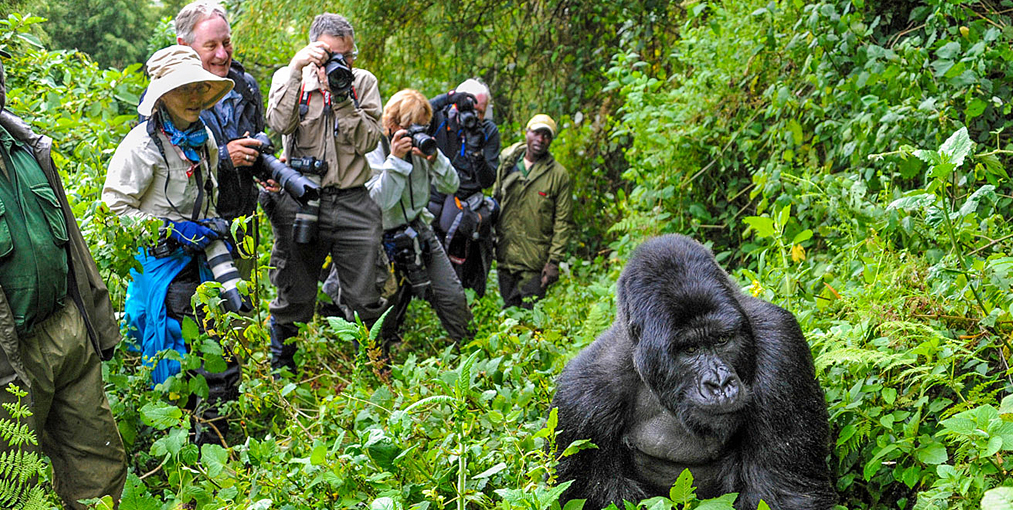
Ready for your ultimate wildlife experience?
Chat with us, our team is always here to help!
You may also like …

Got any questions
about traveling to Uganda?
Get in touch.






